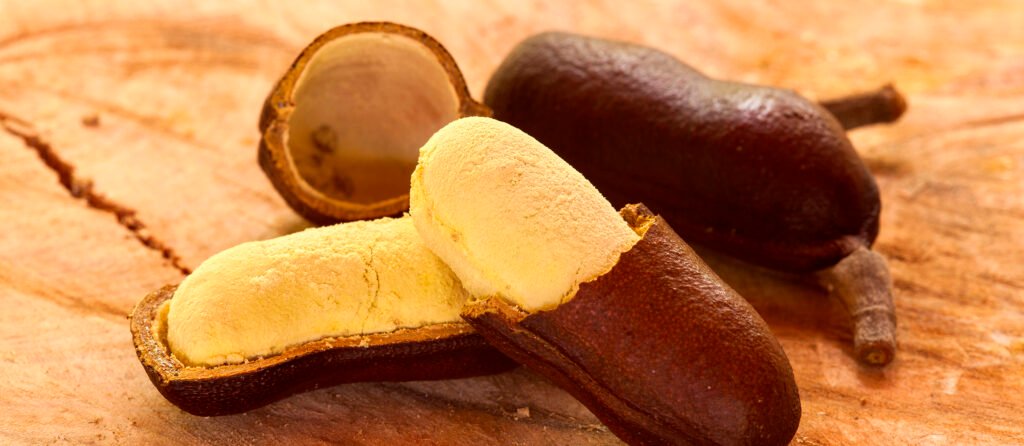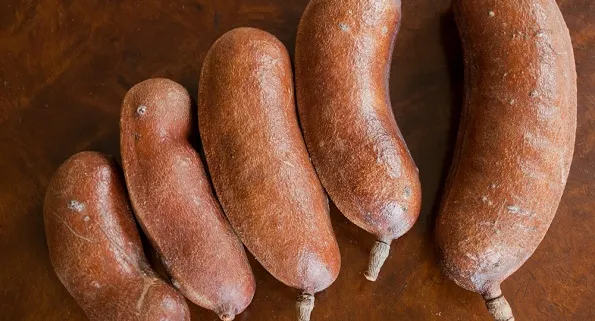
If you can get past the name and the smell, then congratulations: you’ve just discovered one of the Caribbean’s most intriguing tropical treasures.
Known widely as Stinking Toe, this fruit from the towering West Indian Locust tree (Hymenaea courbaril) is a sensory paradox. It is offensive to the nose, yet oddly delightful to the palate. Shaped like a toe and emitting a pungent, earthy odor reminiscent of smelly socks, the Stinking Toe is not for the faint of heart. But for those brave enough to crack open its thick, woody shell, it reveals a dry, powdery pulp that’s surprisingly sweet and packed with health benefits.
Welcome to the wild world of the Stinking Toe fruit.

What’s in a Name? (A Smelly One)
The name Stinking Toe isn’t an exaggeration or a clever marketing ploy. It’s literal. Encased in a hard, oblong pod that mimics the shape of a large toe, the fruit earns its stinky status the moment it’s cracked open. The scent that escapes is often compared to unwashed feet, moldy cheese, or even a teenage gym bag. This is no dainty tropical fruit.
But don’t let your nose fool you. The off-putting aroma conceals a creamy, beige-colored pulp with a taste that can surprise even the most skeptical eater. Descriptions of its flavor range from powdered sugar and dried milk to parmesan cheese with hints of herbs. Sound strange? It is. But somehow, it works.
A Taste of Tradition: Culinary Uses Across the Caribbean and South America
Despite its dubious scent, the Stinking Toe has been treasured for centuries across the Caribbean, Central, and South America. In Jamaica, locals blend the dry flesh with water, sugar, and spices to make a refreshing and nutrient-packed drink. In Brazil, the fruit known as jatobá is ground into flour and used to make broinha, a type of biscuit. Among indigenous communities like the Ikpeng in the Amazon, it’s eaten raw, mixed into porridges, or combined with honey to create a sweet paste.
The powdery pulp dissolves easily in liquids, making it perfect for smoothies, shakes, teas, and even ice cream. Stinking Toe flour is also a popular ingredient in breads, crackers, and cakes, prized not only for its unique taste but also for its dense nutritional profile.
The Funky Fruit That Packs a Nutritional Punch
Beyond its novelty, the Stinking Toe is considered a superfruit for good reason. It’s rich in:
Iron which supports the production of hemoglobin and helps prevent anemia
Vitamin A essential for eye health and maintaining healthy skin
Antioxidants which combat free radicals linked to diseases like cancer and heart disease
Calcium and Phosphorus critical for strong bones and teeth
Magnesium and Potassium important for cardiovascular health and regulating blood pressure
Fiber to aid digestion and keep you full longer
Additionally, it’s touted for its antimicrobial, antifungal, and anti-inflammatory properties. Traditionally, it’s been used to treat ailments such as urinary tract infections, bronchitis, diarrhea, athlete’s foot, and even rheumatism. Some believe it also acts as a mild aphrodisiac and natural energy booster, making it a favorite among athletes and herbalists.
Nature’s Clever Partner: The Agouti
Interestingly, the Stinking Toe tree owes much of its natural propagation to a small rodent called the agouti. Found throughout South and Central America, these clever creatures are the only animals with teeth strong enough to crack the rock hard pods. They bury the seeds in various locations to eat later, a habit known as scatter hoarding. But agoutis, like most of us, forget things. Thanks to their forgetfulness, new West Indian Locust trees sprout and grow across the rainforest, continuing the cycle.
A Fruit of Legends and Longevity
The West Indian Locust tree is one of the tallest in the Caribbean and South America, sometimes reaching up to 45 meters. It takes nearly a decade or more to begin fruiting, but once it does, a single tree can yield up to 50 kilograms of fruit each season. Indigenous peoples in the Amazon have long revered the tree, using its bark, resin, and fruit for medicine, food, and rituals. Warriors once carried the pods as portable sources of energy on long treks through the jungle.
And while modern consumers might giggle at the name or recoil at the scent, this Old Man’s Toe or Jamaican Locust Fruit is still a staple in regional diets and folk medicine traditions.
From Funk to Fame: Why You Should Try Stinking Toe
So, should you eat it? Absolutely. Just maybe hold your nose the first time.
Behind the funny name and foot like fragrance is a fruit with remarkable health benefits, cultural significance, and a truly one of a kind flavor. Whether you enjoy it in a smoothie, baked into biscuits, or straight from the pod like island children do, the Stinking Toe deserves its place among the Caribbean’s beloved and beneficial fruits.
In a world where appearances and aromas can be deceiving, the Stinking Toe is proof that sometimes the best things come wrapped in the most unexpected packages.
Fun Fact
If your Stinking Toe fruit doesn’t have a smell, it may actually be too old to eat. A little stink goes a long way.
Where to Find It
Stinking Toe fruits are in season during the summer and can be found in fresh markets across Jamaica, Trinidad, Brazil, and parts of Central America. You can also find stinking toe flour and supplements online for a funky, flavorful boost to your diet.
Whether you’re an adventurous eater, a health enthusiast, or a cultural explorer, give the Stinking Toe a chance. Your nose may protest, but your body and your taste buds just might thank you.
